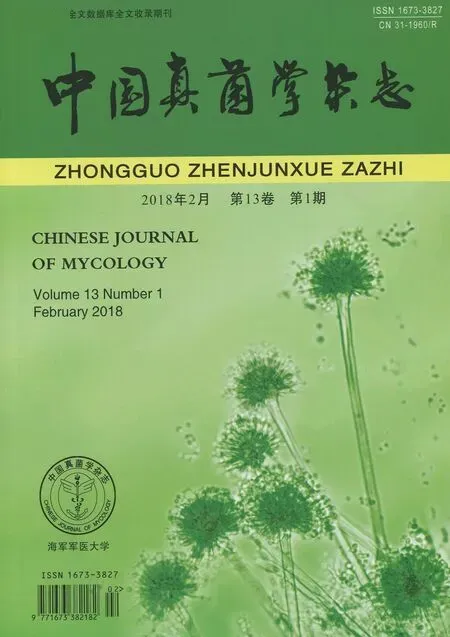中国侵袭性曲霉菌病流行病学现状
2018-02-05徐媛陈敏廖万清
徐媛 陈敏 廖万清
(第二军医大学长征医院皮肤科,上海 200003)
近年来由于各种免疫抑制剂的使用、器官移植的开展、HIV人群的增多,侵袭性曲霉菌病 (IA)的发病率明显上升,已成为仅次于侵袭性念珠菌病的第2位深部真菌感染。IA是1种机会性真菌感染,诊断困难,并有极高的死亡率。现中国尚缺乏关于IA的大型多中心流行病学调查研究,本文就中国目前有关IA的流行病学研究情况概述如下。
1 病原学特点
曲霉菌属于无性繁殖的丝状真菌[1],其在自然界中无处不在,常见于湿润的土壤或农业环境中,也可见于谷类、发霉的面包、其他腐烂物等[2]。它们对生长环境的要求不高,能在6~55℃以及相对低湿度的环境中生长[1]。曲霉能产生大量的孢子,并可通过空气传播进行大范围的扩散。2014年杨蓉娅[3]报道医院内的空气、物体表面、自来水等环境中均发现了曲霉菌,表明临床患者的感染很可能来自医院内环境。另外国际研究报道气温变化可影响曲霉的生长以及空气中孢子的浓度[4],这很可能造成不同气候地区间曲霉感染的差异。虽然我国尚无关于不同气候地区间曲霉感染的大型对比研究,但国内1项研究表明伴基础疾病的患者感染侵袭性肺曲霉菌病 (IPA)有季节性的差异,这可能与基础疾病的季节性变化相关[5]。
目前世界上已发现约有800种曲霉[1],约30种曲霉可引起人类感染,其中常见的曲霉有烟曲霉、黄曲霉、黑曲霉、土曲霉以及构巢曲霉等[6]。
2 流行病学
IA的发病率不断上升。据保守估计,目前全球有29万例慢性肺曲霉病 (CPA)患者,484万例过敏性支气管肺曲霉病 (APBA)患者,其中中国约有4万例CPA患者,49万例APBA患者[7]。目前欧洲约有6万例IA患者,而中国IA患者至少16万例[8]。同时IA是1种严重的致死性感染,全球IA的死亡率为30%~95%[9],中国的死亡率为39%~100%[5,10],死亡率的高低主要与基础疾病、感染部位、治疗、耐药情况等有关。大量人群受累以及不断增加的发病率和极高的死亡率对国家和个人均造成了巨大的经济负担。
IA是机会性真菌感染,容易合并感染于器官移植、中性粒细胞减少症、肿瘤、使用免疫抑制剂、慢性肺部疾病、HIV、糖尿病等患者,但近年来无基础疾病患者感染IA的报道不断增加[5,11-12]。目前国内研究报道IPA患者中无基础疾病患者约占20%[5]。
与国际报道一致[12],国内多个研究表明肺部真菌感染中曲霉菌感染最多见 (37.9%~57%)[13-15],同时曲霉菌感染最常见于肺部 (71.9%)[16]。我国曲霉菌感染中,烟曲霉感染最多见 (46%~60%),其次为黄曲霉 (27%~36%)、黑曲霉 (2%~8%)、土曲霉 (2%~7%)等[16-18]。值得注意的是,虽然黑曲霉属占曲霉菌感染中的第3位,但在耳真菌病中是最常见的致病菌。2015年李若瑜研究报道中国黑曲霉属中塔宾曲霉 (A.tubingensis)和黑曲霉 (A.niger)均是耳真菌病的最主要致病菌,且两者所占比例无差别[19]。同国际报道一致[20],烟曲霉虽仍是IA主要致病菌,但近年来比例有所下降,而黄曲霉、黑曲霉、土曲霉等非烟曲霉报道例数不断增加[16]。同时一些少见曲霉菌感染的报道也在增加,例如廖万清报道了国内外首例具多育现象的米曲霉引起肺曲霉球病[21],以及首例聚多曲霉引起的阻塞性支气管曲霉菌病[22],这可能与菌种鉴定技术的不断发展有关。
自1997年首次报道伊曲康唑耐药烟曲霉以来,全球对唑类耐药烟曲霉的报道不断增加。目前我国唑类耐药烟曲霉的突变率为1.4%~5.6%[18,23-24],与国际报道类似 (2.1%~8%)[24]。国内外研究均表明大部分的烟曲霉唑类耐药机制均与Cyp51A基因有关,并且已经发现了至少15个耐药相关的突变位点,例如:TR34/L98H、TR46/Y121F/T289A、G54、G138、M220、G432、G448等[8,24]。2007年荷兰首次发现TR34/L98H突变后,2011年我国在ARTEMIS全球监测研究中首次发现该突变的烟曲霉菌株,其与多唑类耐药相关[6,25]。同国际研究报道一致[26],TR34/L98H突变是我国最常见的烟曲霉唑类耐药机制,主要分布在东南和华北地区[8,23-24]。2011年荷兰首次发现烟曲霉中TR46/Y121F/T289A突变后,2015年我国首次发现该突变,其与伏立康唑耐药密切相关[27-28]。国外研究提示烟曲霉Cyp51A基因相关的耐药机制中,TR46/Y121F/T289A突变比例仅次于TR34/L98H,虽然我国尚缺乏TR46/Y121F/T289A突变的流行病学数据,但报道例数不断上升,需继续监测该位点突变情况[26,29]。
黄曲霉虽是IA的第2位致病菌,但是有关其耐药的报道远少于烟曲霉。值得注意的是,2012年李若瑜[30]首次报道了临床上伏立康唑耐药的黄曲霉,并证实Cyp51C基因中T788G位点突变与伏立康唑耐药密切相关。随着非烟曲霉唑类耐药的出现,我国需进一步加强对曲霉耐药的监测。
3 诊 断
由于曲霉感染无特异性表现,且致病菌检出时间较长,故IA的早期诊断十分困难且易误诊。国内研究报道IPA误诊率可高达73%[31]。根据2008年欧洲癌症-侵袭性真菌感染治疗研究协作组和美国国立变态反应和感染病研究院真菌研究组 (EORTC/MSG)修订的侵袭性真菌感染临床研究标准化分级[32],曲霉病的诊断分为3级:确诊、拟诊和疑诊。目前诊断方法有:镜检、培养、组织病理学、影像学、半乳甘露聚糖抗原 (GM试验)、1,3-β-D葡聚糖抗原 (G试验)、核酸检测 (PCR)等。最近国外研发了一种快速诊断IA的免疫层析测流装置 (LFD),具有较高的敏感性和特异性[33],目前英国已批准上市,但我国暂未批准。
4 治 疗
既往我国指南将伊曲康唑作为IA的首选治疗药物[34],但是越来越多的国内外研究表明伏立康唑相比两性霉素B和伊曲康唑可更加明显降低死亡率[10-11,35-36]。2016年更新的美国感染病学会临床实用指南推荐伏立康唑为IA的首选治疗药物,两性霉素B、卡泊芬净、伊曲康唑等作为备选,另外卡泊芬净推荐用于危重患者的治疗,必要时联合用药以及结合手术治疗[37]。目前国内部分地区治疗药物的选择上仍参差不齐,需进一步加大IA治疗指南的推广力度。
5 总 结
侵袭性曲霉菌病是重要的机会性深部真菌感染。曲霉菌可广泛分布于自然环境中,可接触大量人群,尤其导致免疫受损人群的感染。随着中国免疫抑制人群的不断增加,侵袭性曲霉菌病的发病率也不断上升,这将影响我国人民的健康并造成巨大的经济负担。其次,由于早期诊断仍较困难以及缺少高效性的治疗措施,导致侵袭性曲霉菌病的死亡率仍较高。近年来唑类耐药烟曲霉及非烟曲霉感染的报道均不断增加,大部分耐药机制均与Cyp51基因相关。综上所述,侵袭性曲霉菌病已严重危害人类健康,临床医师应高度注意深部曲霉菌感染,尤其是伴有免疫受损的高危患者,对可疑感染及时进行真菌培养鉴定及药敏试验,并对耐药菌株行耐药基因检测,以助于早期诊断和有效治疗。同时全国各地需继续监测侵袭性曲霉菌病的感染情况,及时掌握曲霉菌感染现状及趋势。
[1] Krijgsheld P, Bleichrodt R, van Veluw GJ, et al. Development inAspergillus[J]. Stud Mycol, 2013, 74(1): 1-29.
[2] Sharma OP, Chwogule R. Many faces of pulmonary aspergillosis[J]. Eur Respir J, 1998, 12(3): 705-715.
[3] Ao JH, Hao ZF, Zhu H, et al. Environmental investigations and molecular typing ofAspergillusin a Chinese hospital[J]. Mycopathologia, 2014, 177(1-2): 51-57.
[4] Porpon R, Chen YC, Chakrabarti A, et al. Epidemiology and clinical characteristics of invasive mould infections: A multicenter, retrospective analysis in five Asian countries[J]. Med Mycol, 2017.
[5] Dai Z, Zhao H, Cai S, et al. Invasive pulmonary aspergillosis in non-neutropenic patients with and without underlying disease: a single-centre retrospective analysis of 52 subjects[J]. Respirology, 2013, 18(2): 323-331.
[6] Lockhart SR, Frade JP, Etienne KA, et al. Azole resistance inAspergillusfumigatusisolates from the ARTEMIS global surveillance study is primarily due to the TR/L98H mutation in the cyp51A gene[J]. Antimicrob Agents Chemother, 2011, 55(9): 4465-4468.
[7] Denning DW, Pleuvry A,Cole DC. Global burden of allergic bronchopulmonary aspergillosis with asthma and its complication chronic pulmonary aspergillosis in adults[J]. Med Mycol, 2013, 51(4): 361-370.
[8] 陈勇,卢中一,靳远,等.烟曲霉对唑类药物耐药研究的最新进展[J].中华流行病学杂志,2016,37(12): 1687-1692.
[9] Brown GD, Denning DW, Gow NA, et al. Hidden killers: human fungal infections[J]. Sci Transl Med, 2012, 4(165): 165rv13.
[10] Wang W, Zhao CY, Zhou JY, et al. Invasive pulmonary aspergillosis in patients with HBV-related liver failure[J]. Eur J Clin Microbiol Infect Dis, 2011, 30(5): 661-667.
[11] Chen J, Yang Q, Huang J, et al. Clinical findings in 19 cases of invasive pulmonary aspergillosis with liver cirrhosis[J]. Multidiscip Respir Med, 2014, 9(1): 1.
[12] Taccone FS, Van den Abeele AM, Bulpa P, et al. Epidemiology of invasive aspergillosis in critically ill patients: clinical presentation, underlying conditions, and outcomes[J]. Crit Care, 2015, 19: 7.
[13] Luo BL, Zhang LM, Hu CP, et al. Clinical analysis of 68 patients with pulmonary mycosis in China[J]. Multidiscip Respir Med, 2011, 6(5): 278-283.
[14] Chen KY, Ko SC, Hsueh PR, et al. Pulmonary fungal infection: emphasis on microbiological spectra, patient outcome, and prognostic factors[J]. Chest, 2001, 120(1): 177-184.
[15] 刘又宁,余丹阳,孙铁英,等.中国1998年至2007年临床确诊的肺真菌病患者的多中心回顾性调查[J].中华结核和呼吸杂志,2011,34(2): 86-90.
[16] 高露娟,余进,李若瑜.中国大陆地区曲霉病流行现状分析[J].中国真菌学杂志,2010,5(4):247-251.
[17] Shi JY, Xu YC, Shi Y, et al.Invitrosusceptibility testing ofAspergillusspp. against voriconazole, itraconazole, posaconazole, amphotericin B and caspofungin[J]. Chin Med J (Engl), 2010, 123(19): 2706-2709.
[18] Zhang M, Feng CL, Chen F, et al. Triazole Resistance inAspergillusfumigatusclinical isolates obtained in Nanjing, China[J]. Chin Med J (Engl), 2017, 130(6): 665-668.
[19] Li Y, Wan Z, Liu W, et al. Identification and susceptibility ofAspergillussection nigri in china: prevalence of species and paradoxical growth in response to echinocandins[J]. J Clin Microbiol, 2015, 53(2): 702-705.
[20] Baddley JW, Stroud TP, Salzman D, et al. Invasive mold infections in allogeneic bone marrow transplant recipients[J]. Clin Infect Dis, 2001, 32(9): 1319-1324.
[21] Liao WQ, Shao JZ, Li SQ, et al. Mycological identification of pulmonary aspergilloma caused byAspergillusoryzaewith proliferating heads[J]. Chin Med J (Engl), 1988, 101(8): 601-604.
[22] Liao WQ, Wen H, Chen YC, et al. The first case of obstructing bronchial aspergillosis caused byAspergillussydowi[J]. Int J Infect Dis, 2004, 8(2): 132-133.
[23] Chen Y, Lu Z, Zhao J, et al. Epidemiology and molecular characterizations of azole resistance in clinical and environmentalAspergillusfumigatusisolates from China[J]. Antimicrob Agents Chemother, 2016, 60(10): 5878-5884.
[24] Liu M, Zeng R, Zhang L, et al. Multiple cyp51A-based mechanisms identified in azole-resistant isolates ofAspergillusfumigatusfrom China[J]. Antimicrob Agents Chemother, 2015, 59(7): 4321-4325.
[25] Verweij PE, Mellado E, Melchers WJ. Multiple-triazole-resistant aspergillosis[J]. N Engl J Med, 2007, 356(14): 1481-1483.
[26] van der Linden JW, Camps SM, Kampinga GA, et al. Aspergillosis due to voriconazole highly resistantAspergillusfumigatusand recovery of genetically related resistant isolates from domiciles[J]. Clin Infect Dis, 2013, 57(4): 513-520.
[27] Chen Y, Wang H, Lu Z, et al. Emergence of TR46/Y121F/T289A in anAspergillusfumigatusisolate from a Chinese patient[J]. Antimicrob Agents Chemother, 2015, 59(11): 7148-7150.
[28] Vermeulen E, Maertens J, Schoemans H, et al. Azole-resistantAspergillusfumigatusdue to TR46/Y121F/T289A mutation emerging in Belgium, July 2012[J]. Euro Surveill, 2012, 17(48).
[29] Hagiwara D, Watanabe A, Kamei K, et al. Epidemiological and genomic landscape of azole resistance mechanisms in Aspergillus fungi[J]. Front Microbiol, 2016, 7: 1382.
[30] Liu W, Sun Y, Chen W, et al. The T788G mutation in the cyp51C gene confers voriconazole resistance inAspergillusflavuscausing aspergillosis[J]. Antimicrob Agents Chemother, 2012, 56(5): 2598-2603.
[31] Zhang R, Wang S, Lu H, et al. Misdiagnosis of invasive pulmonary aspergillosis: a clinical analysis of 26 immunocompetent patients[J]. Int J Clin Exp Med, 2014, 7(12): 5075-5082.
[32] De Pauw B, Walsh TJ, Donnelly JP, et al. Revised definitions of invasive fungal disease from the European Organization for Research and Treatment of Cancer/Invasive Fungal Infections Cooperative Group and the National Institute of Allergy and Infectious Diseases Mycoses Study Group (EORTC/MSG) Consensus Group[J]. Clin Infect Dis, 2008, 46(12): 1813-1821.
[33] Guinea J, Bouza E. Current challenges in the microbiological diagnosis of invasive aspergillosis[J]. Mycopathologia, 2014, 178(5-6): 403-416.
[34] 中华内科杂志编辑委员会.血液病/恶性肿瘤患者侵袭性真菌感染的诊断标准与治疗原则(修订版)[J].中华内科杂志,2007,46(7): 607-610.
[35] Chen J, Yang Q, Huang J, et al. Risk factors for invasive pulmonary aspergillosis and hospital mortality in acute-on-chronic liver failure patients: a retrospective-cohort study[J]. Int J Med Sci, 2013, 10(12): 1625-1631.
[36] Li D, Chen L, Ding X, et al. Hospital-acquired invasive pulmonary aspergillosis in patients with hepatic failure[J]. BMC Gastroenterol, 2008, 8: 32.
[37] Patterson TF, Thompson III GR, Denning DW, et al. Practice guidelines for the diagnosis and management of aspergillosis: 2016 update by the Infectious Diseases Society of America[J]. Clin Infect Dis, 2016, 63(4): e1-e60.
